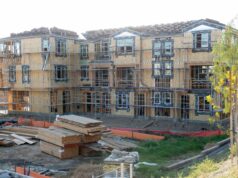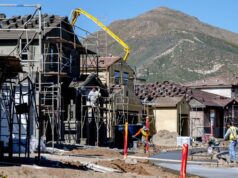You’ve likely read headlines about The Inflation Reduction Act — which sets aside around $369 billion for clean energy projects. But if you’re a homeowner, homebuyer, or seller, you’re probably wondering how this massive bill affects you. Fortunately, you don’t have to sift through the more than 750-page document to find out.
In this post, we’ll reveal some of the housing-related benefits of The Inflation Reduction Act.
Our experts will share how the act helps to pay for upgrades including energy-efficient windows, doors, solar panels, or even a new electric oven. Using these incentives, you can save money, reduce environmental impact, and increase the value of your home.
What is the Inflation Reduction Act?
The Inflation Reduction Act was passed in August of 2022, and it carves out billions of dollars for companies, families, and individuals to push toward environmental and climate projects. According to Owen Minott, a senior policy analyst on the Bipartisan Policy Center’s housing and infrastructure team, there are two types of assets the bill includes for homeowners, sellers, and buyers:
-Tax credits
-Federal grants
“I really see the bill as having two categories of housing-related investments,” says Minott. “There’s $18 billion in Federal grants over 10 years, and then there are $36.5 billion in tax credits over 10 years.”
Homeowners can start collecting tax credits during 2023 for qualifying upgrades. As for grants, most of those projects are still forming, and they’re divided out on a state-by-state basis, so the details for that second category may still be in the works.
What does the Inflation Reduction Act do for homeowners?
Starting January 1 of this year, homeowners can make qualifying investments in their homes and write off a portion of those investments under the Inflation Reduction Act. That means, if you want to increase your home’s energy efficiency, or you’ve been putting off a maintenance project that qualifies, it may be a smart time to cash in.
“Upgrades for energy efficiency and energy affordability are really valuable,” says Minott. “They can save costs, provide resilience to disasters, and reduce pollution in communities, so even if they’re not the housing affordability type of investments that a lot of housers have been focused on, they can really be beneficial.”
Here are a few ways you can use the Inflation Reduction Act to improve your housing situation:
1. Assess your housing energy needs at a discount
Many homeowners want to upgrade to a greener, more efficient home but don’t know where to start. If this is your situation, you may benefit from The Inflation Reduction Act’s tax credit for energy audits. According to Energy.gov, you can shave 30% off your energy audit cost, up to $150, if you hire a qualifying inspector.
“Energy audits are really key because that can actually help low-income or middle-income families figure out which of all of these projects that are newly available are well-suited to their home,” explains Minott.
Bringing in an energy professional to assess your home could be an easy way to start pinpointing what investments will enhance your home the most.
2. Upgrade your heating and cooling systems for less
With the Energy Efficiency Home Improvement Credit, homeowners can cut 30% off investments in energy-efficient heat pumps, biomass stoves, and energy-efficient boilers, up to $2,000. And it includes breaks for smaller efficiency upgrades.
Minott explains that the Energy Efficient Home Improvement Credit “covers energy-efficient exterior windows and doors, home energy audits, and installing heat pumps. And that tax credit is up to a maximum of $1,200 for most projects.” He adds that the credit can also cover “biomass stoves, and boilers, for up to a maximum of $2,000.”
That means, if you spend a total of $4,000 installing more efficient exterior windows and doors, along with $10,600 switching to a more eco-friendly boiler or another qualifying system, you could potentially receive close to $3,200 back in tax credits.
3. Lower costs to retool your energy system
Refitting your energy systems with solar panels, wind turbine systems, battery storage technology, or other renewable energy equipment can boost the value of your home — and trim down your energy bill. Unfortunately, these systems can be expensive to install. In fact, according to the Center for Sustainable Energy, the average cost of a residential solar system is between $15,000 and $25,000.
Under the Inflation Reduction Act’s Residential Clean Energy [Tax] Credit, you can offset a large portion of these costs. It provides a 30% credit to install energy-efficient systems. Some examples include:
Solar power systems
Wind-powered systems
Geothermal systems
Biomass fuel systems
This credit also isn’t capped, so even if you take on an expensive project, you can still qualify for the 30% tax break. For instance, if you decide to convert your home’s power to an off-the-grid solar system, and it costs $50,000, you could receive up to $15,000 in tax credits.
To avoid complications with tax credits, Stephen Walls, a building decarbonization advocate for the Natural Resources Defense Council’s (NRDC) Climate & Clean Energy Program, says he suggests buying new systems outright, rather than leasing or renting equipment.
“Make sure they purchase a system rather than do a long-term lease,” he says. “If you want the tax credit, it’s better to purchase the system rather than lease it.”
4. Reduce your energy bills and save
If you’re a homeowner, you may be able to earn a rebate when your new installations cut down energy consumption. With the Home Owner Managing Energy Savings (HOMES) Rebate Program, homeowners may be able to earn rebates, depending on how much their project upgrades reduce energy consumption. Here’s how the program breaks down, in general:
If a homeowner cuts 20% usage: $2,000 rebate
If a homeowner cuts 35% usage: $4,000 rebate
To qualify for these rebates, homeowners need to achieve energy reductions through qualified home renovations. There’s also a 50% total project cap on these rebates.
Additionally, low and moderate-income households can earn even higher rebates under the program. If your income is 80% or less than your area’s median income, you could qualify for double the rebates. That means:
If a homeowner cuts 20% usage: $4,000 rebate
If a homeowner cuts 35% usage: $8,000 rebate
5. Discount energy-efficient appliances
If you fall within the low-to medium-income bracket, you may also qualify for the High-Efficiency Electric Home Rebate Act. Under this program, you could receive up to $14,000 in point-of-sale consumer discounts for a wide range of energy-efficient appliances and projects.
Wondering what appliances are covered by this section of the Inflation Reduction Act? Here’s a list of some of the projects and appliances it includes:
Heat pump, space heating, and HVAC projects: up to $8,000
Insulation and sealing improvements: up to $1,600
Installing an energy-efficient heat pump water heater: up to $1,750
Electrical wiring improvements: up to $2,500
Electric load center upgrades: up to $4,000
Electric stove, oven, and cooktop additions: up to $840
6. Trim costs for backup generators
If you rely on a gas-powered backup generator for your home, it could be the right time to switch to a more energy-efficient option.
“[The Inflation Reduction Act] also enriches the tax credit for distributed solar and includes batteries for the first time,” says Walls. “So if you were interested in switching from a gas backup generator for your home, and you wanted to go to clean energy, now’s a good time to make that switch.”
The Inflation Reduction Act extends and adds to an existing tax credit called the “Investment Tax Credit (ITC).” In addition to reinstating a 30% credit for solar projects, the law change also adds tax credits for standalone electricity storage. That means you could pick up a residential battery, with a three-kilowatt capacity, and receive a 30% credit.
How can the Inflation Reduction Act help buyers or sellers?
Homeowners aren’t the only ones who can benefit from the Inflation Reduction Act. Here are a few ways you can use these energy-efficiency incentives to your benefit if you plan on buying or selling a home:
Benefits for buyers
High inflation and an upswing in mortgage rates both are layering extra financial pressure on homebuyers. Buyers can cut down some of their daily costs by looking for energy-efficient homes. As the Inflation Reduction Act takes effect, Gene Darden, a top agent in Helena, Alabama, says he expects homebuyers to start paying more attention to energy costs and searching for homes that cut down monthly energy expenses.
“So one of the number one things we’re going to get as we’re working through contracts is, [buyers saying] ‘Hey, can you share utility bills to make sure what the cost is of this home? What’s it cost me to live this whole month from an energy standpoint, and what advantages do I have?’” says Darden, who works with 80% more single-family homes than the average agent in his market.
As more homeowners use the Inflation Reduction Act to improve their home’s efficiency, buyers could see more properties with lower power bills. Darden says these energy upgrades could help offset the price hikes that are hitting many buyers.
“Let’s say you have one home, and power on that home is $600 a month. And you’ve got another home, and power on that home is $300 a month,” he explains. “Well, you just eliminated a big part of what they’re having to absorb by paying extra on that interest rate on the mortgage on the house.”
Benefits for sellers
Home sellers can also benefit from the Inflation Reduction Act. Tax credits give sellers a chance to upgrade their home, and add value to their property, at a discount.
“Everyone’s looking for clean energy, reduced footprints, those types of things,” says Darden. “When you layer in dollar-for-dollar tax credits and things like that, it gives a seller several options to go ahead and add some of those things to their home, which is going to make it much more attractive to a buyer.”
HomeLight’s Top Agent Insights New Year 2023 found that 41% of agents believe energy-efficient appliances will be a popular upgrade with buyers. And in HomeLight’s Summer 2022 Insights, 48% of agents said buyers were prioritizing energy-efficiency features. That means you may be able to increase your home’s listing price with clean energy upgrades and receive tax credits through the Inflation Reduction Act.
How do I qualify for Inflation Reduction Act rebates and credits?
Qualifying for some Inflation Reduction Act benefits is fairly straightforward. Others may take time to navigate. That’s because there are two broad categories of benefits: tax credits and grants.
“For the tax credits, it’s relatively easy. If you’ve made a qualifying credit and you owe taxes, you can claim a credit,” says Walls.
However, for Inflation Reduction Act grants, which are mostly handled by states and tribes, the final details are still forming.
“The rebate programs for low- and moderate-income households are still being designed, and the states will implement those — and each state will have its own rules and guidelines for that,” explains Walls.
If you want to know if you qualify for those programs, Minott suggests watching out for state-by-state specifics as they come out.
“On the grant side, keep an eye out for your state to release that information,” he says.
How to use homeowner tax credits
Tax credits for the Inflation Reduction Act kicked into action on January 1, 2023. That means homeowners can cash in on many energy-efficient upgrades within the next year.
Walls says the best way to move forward if you want to claim tax credits is to find a contractor who is familiar with qualified equipment and work with them to make sure installations qualify. If you want to complete projects on your own, he suggests visiting your product manufacturer’s website, finding your item’s product number, and checking to see if that piece of equipment qualifies.
Here are a few resources to help you learn more about the Inflation Reduction Act and your housing options:
Energy.Gov’s Clean Energy Tax Credit List
Inflation Reduction Act Guidebook
Rewiring America’s IRA Calculator
Start enhancing your property and collecting tax credits
Although the Inflation Reduction Act isn’t centered exclusively on housing upgrades, it includes tax credits and rebates that homeowners, sellers, and buyers can use to gain an edge. If you’re not sure what clean energy upgrades to make, consider hiring a professional to conduct an energy audit or discuss your options with a tax professional. If you’re selling your home, ask your real estate agent for help. In all cases, by tapping into the Inflation Reduction Act, you can save money, boost your home’s value, and cut down energy consumption — as you help clean up your neighborhood along the way.
Header Image Source: (iriana88w / Depositphotos)
HomeLight Blog | Read More











